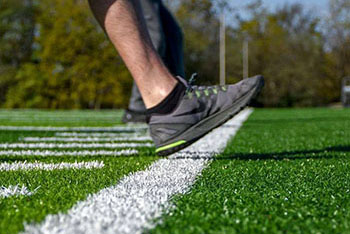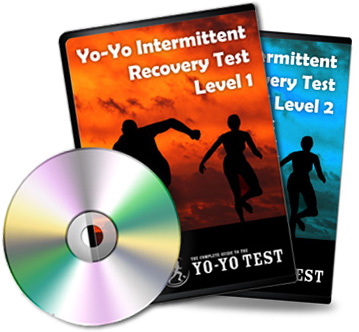Yo-Yo Test Alternatives
Not only are there the six official yo-yo test versions as created by Jens Bangsbo, there are also a couple of modified versions of the yo-yo test, and many alternatives to the yo-yo test that measure similar aspects of fitness. The alternatives to the yo-yo test below are grouped as either sets of repeated maximal sprints with a set rest period, or sprints of variable speed and/or variable rest periods.
Repeat Sprint Tests
These repeat sprint tests measure not only anaerobic power, but also the ability to recover from these bursts of high-intensity exercise. For these tests, the participants sprint at maximum speed over a set distance or time, with minimal predetermined rest periods. The sprints are repeated 6 to 10 times.
Example Repeat Sprint Tests:
- Sprint Fatigue Test — 10 x 30m sprints.
- Phosphate Recovery Test — 7 x 7 second sprints.
- Running Based Anaerobic Sprint Test (RAST) — 6 x 35m sprints.
- AFL Sprint Recovery Test — 6 x 30m sprints.
- FIFA Interval Test 1 — 6 x 40m sprints.
Intermittent Speed Tests
There is another category of tests that more closely replicate the demands of team sports, where the sprints (and recovery periods) are variable in intensity and duration.
- Loughborough Intermittent Shuttle Test — this test includes periods of jogging, running and sprinting, designed to simulate the demands of soccer matches. The protocol involves moving between two lines 20 meters apart, at speeds set based on the player's individual fitness levels and relevant to the sport that is being simulated. Audio signals dictate the speeds they run at. The standard test for male soccer players involves 6 x 15 minute blocks of exercise, separated by three minute rest intervals, making a total of 90 minutes of activity. Each 15 minute block consists of approximately 11 cycles: 3 x 20m walking, 1 x 15m sprint, 3 x 20m running, and 3 x 20m jogging.
- Soccer FIT Interval Test — this test was developed initially to mimic the demands of soccer players, and involves running 10 and 25 yard circuits in diminishing times, with a 30 second rest between sets.
- 30-15 Intermittent Fitness Test — this test was designed to closely replicate the demands of intermittent sports. Unlike the beep test, where athletes run continuously with increasing speed every minute, this test involves 30 seconds of running alternated with 15 seconds of walking over a 40m shuttle area.
- Gacon Test (Running 45"/15") — like the 30-15 intermittent test, though running for 45 seconds on an oval track.
- The J.A.M. Intermittent Test — developed to measure the intermittent fitness ability of team sport athletes, specifically Rugby players. The test involves a series of walk–jog–run shuttles. The participants loop around a triangular circuit, either running, walking or jogging in that order. Approximately every two minutes the run is replaced with a maximal effort 12 meter sprint.
- FIFA Interval Test 2 — This test is part of the test protocol for soccer referees. The test is 12 laps in total, with each lap comprising 2 x 150m high intensity runs with 50m walk between each.
- Andersen Test — subjects run back and forth on a 20m track. After 15 seconds they stop and rest for the next 15 seconds. This procedure is followed for 10 minutes. Subjects run as fast as they can in order to cover the longest possible distance during the 10-minute test.
More Resources
- About the six variations of the yo-yo fitness test
- How to determine which version of the yo-yo test you did
- Modifications of the Yo-Yo Test
- Comparing the beep and yo-yo tests
- List of information pages
- Buying the Yo-Yo Test
Cite this Page


